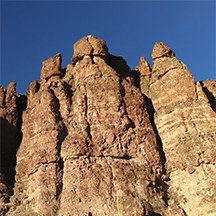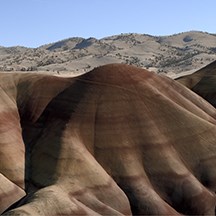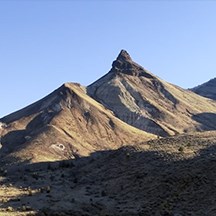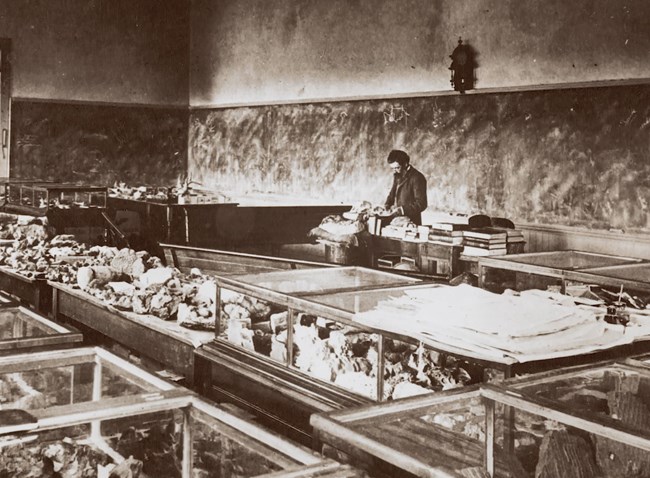Last updated: December 8, 2025
Article
Junior Ranger Program

What does it mean to be a Junior Ranger?
- Discover by using your senses.
- Find clues to ancient habitats.
- Imagine ancient plants and animals.
- Explore the trails, visitor center, and historic areas.
- Observe, reflect and learn, so you can help protect this very special place.
How to Become a Junior Ranger
| Activities at the Park - Earn a wood Jr Ranger badge | Activities at Home - Earn a digital Jr Ranger badge |
| Hike a trail | Take a walk |
| Attend a ranger-led program or talk to a ranger | Call or e-mail a ranger and ask a question about the park |
| Watch the park film | Watch the park film |
| Complete as many activities in the booklet as you can | Complete as many activities on this page as you can |
You can work alone, with your friends, or with your family.

Ways to Earn a Junior Ranger Badge
When you are finished you can either:
- Print then cut your own badge now.
- Show your work to a ranger at the Thomas Condon Visitor Center in the Sheep Rock Unit. Then you will receive your wooden Junior Ranger badge!

Discovering John Day Fossil Beds
Explore! This place is a window where we can take part in a rare view into ancient Oregon. Looking through geologic and fossil records we can go back millions of years in time and find very different places than we see today.Discover! You will discover an ancient world millions of years after dinosaurs roamed the earth. An age filled with lumbering rhinos and stalking saber-tooths.
Imagine! Today, scientific discoveries happen right in front of you, as paleontologists unearth fossils never seen by human eyes.
Safety First!
- Hydrate: Be sure to drink lots of water while driving and hiking around John Day Fossil Beds.
- Get Comfortable: Wear good shoes, a hat, and sunscreen.
- Take Care: Be careful where you put your hands and feet: snakes and spiders may be resting under rocks and in holes.
- Be Good Company: Hike with other people. If you get lost, stay in one place.

Map Your Visit
Where am I in John Day Fossil Beds National monument?
The John Day Fossil Beds are unique with one of the longest and most continuous records of evolutionary change in the world. This 14,000 acre monument includes three very different units: Clarno, Painted Hills, and Sheep Rock.Inside the dotted circles below, stamp your Jr. Ranger booklet at each unit when you stop there, or collect all three at the visitor center!
If you are completing this booklet online, virtually explore the Clarno, Painted Hills, and Sheep Rock units by visiting their webpages, and then check off each unit.

Where did it happen on the Geologic Timeline?
In geologic time, an epoch is a measure that’s shorter than a period, which is shorter than an era. Most of the fossils found here were deposited during the Cenozoic Era. Look at the timeline. Now draw lines here connecting the epoch name to when you think it happened.| Time Era | Draw a Line Connecting the Two | Years |
| Paleocene | 11,700 years ago - present day | |
| Eocene | 55.8 Ma to 33.9 Ma | |
| Pliocene | 5.33 Ma to 2.58 Ma | |
| Miocene | 23 Ma to 5.33 Ma | |
| Oligocene | 33.9 Ma to 23 Ma | |
| Pleistocene | 2.58 Ma to 11,700 years ago | |
| Holocene | 65.5 Ma to 55.8 Ma |
Ma (Megaannum) is equal to one million years! Mega comes from ancient Greek and means million, the word annum comes from ancient Latin and it means year. How many years are in a Gigaanum (Ga)?
Different places in Time — find out when they were!
Read the descriptions below. Find the different eras and epochs words in the information on the park's units: (Paleocene, Eocene, Pliocene, Miocene, Oligocene, Pleistocene, and Holocene). Then determine the age range of the rocks found in each unit. The Geologic Timeline activity will help you finish this activity.

Clarno Unit
Marching across the horizon, these 200-foot-tall pillars of ancient mud tower over the landscape. The Clarno Palisades preserve the remains of an Eocene tropical rainforest filled with crocodiles, banana trees, and brontotheres. Hiking the Clarno trails you will discover real fossils that tell a story of a place much different than the one we see in today’s Holocene epoch!
Painted Hills Unit
Like no other place in Oregon, a rainbow of colors splashes across these rolling hills, telling a story of the power of erosion and revealing remains from the Eocene and Oligocene epochs. The trails through the Painted Hills will take you to places like you’ve never seen before!

Sheep Rock Unit
Places to explore! From the Blue Basin badlands to the amazing Cenozoic era fossils on display in the Thomas Condon Paleontology and Visitor Center and from the historic James Cant Ranch and orchard to the large fossil deposits spanning from the Oligocene to the Miocene epochs, the Sheep Rock Unit has something for everyone!
Assemble a Skeleton
Help put the Pogonodon Back Together!
You can either try to draw the missing bones back in place, or draw lines pointing towhere you think these bones should go.
The Past is Present… Beneath Your Feet!
Think of something that surprised you, something unexpected that youlearned today. What was it? Either write down your answer, e-mail a park ranger, tell a family member, or draw a picture.

Early Fossil Hunters
Complete this story about some of the first Western fossil collectors in the John Day Basin by using the hints in parentheses or by referring to the word bank below.
Word Bank
| key role | The Dalles | University of Oregon | paleontologists |
| fossils | competitive | John Day Fossil Beds | 3,000 pounds |
| Berkeley | significant loss | 1889 |
Edward Drinker Cope and Othniel Charles Marsh were internationally known ___________________ who visited the region in the late 1800s. Cope, was from the University of Pennsylvania, and Marsh, came from Yale University. They were very______________, often debating each other over the many fossil discoveries each made across the country, much to the educational enjoyment of many Americans.
Thomas Condon, a Congregational Minister from _____________ (a city in Oregon), was an avid naturalist when he first visited this valley in 1865 in search of ________________ . He was the first to recognize the importance of the __________ ________ ___________ ___________. Condon later became Oregon’s first State Geologist and the first professor of geology at the ________________ ___ ________________ in Eugene, a remarkable person in early Oregon history.
Paleontologist John C. Merriam, of the University of California, first visited the John Day Fossil Beds in 1899. It was the first of many _____________ expeditions sent here between 1899 and the 1920s. These expeditions played a _______ _________ in placing the John Day Fossil Beds in their geological, chronological, and paleoecological context.
William Berryman Scott, of Princeton University, visited here in _______, his team collecting over _________ ___________ of fossils from the Turtle Cove area, which they sent back to the university. Later, after being stored in a cellar, workmen on a project pillaged and destroyed all but a few of the specimens, a _______________ ________ to science.

What’s in a Name?
Match the question to the Horses pictured (Orohippus, Pliohippus, Equus, and Miohippus) and write your answer in the blank spaces.
1.) I became extinct on the North American Continent 10,000 years ago, I’m _ _ _ _ _ __
CLUE: Spanish explorers reintroduced them to the Americas in the 1530s.
2.) I ran on tiptoes for a speedy get-away from hungry predators, I am _ _ _ _ _ _ _ _ _
CLUE: Three-toed horses and short-faced dogs co-existed in the Turtle Cove area. Longer legs and fewer toes on each foot made them faster runners through forests and meadows.
3.) I ran on the tips of only one toenail, I’m _ _ _ _ _ _ _ _ _ _
CLUE: Find where deciduous forests changed into open steppe with predators such as running bears and big cats. Increased running speed resulted from longer legs and single hooves.
4.) I am twelve inches tall and eat no grass, I am _ _ _ _ _ _ _ _ _
CLUE: This small horse ate only leaves, green shoots, and fruit while living in the Clarno Jungle. Four small toes on each foot spreads the weight out, helping to keep them from sinking into the mud.

Senses of Wonder
Take time to explore these places with your eyes, ears, nose, and touch. Wake up your senses to better understand what’s all around you. Try these activities along a park trail or within your backyard.LISTEN
Find a place to sit down and close your eyes. Listen to the sounds around you. Write down what you hear here.SMELL
As you travel through the park or within your backyard, you may notice many scents. Describe some of the different smells you’ve encountered.TOUCH
Gently touch nearby plants. What does it feel like?LOOK
Try a new angle... get down low to the ground and study the area around you. What do yousee now?

Take Care of Our National Treasures!
During your stay in John Day Fossil Beds National Monument:- Please do take pictures, take away rich and lasting memories, and take your time exploring the area.
- But please, don’t take rocks, flowers, or other natural items. This will ensure that our wild animals have the things they need to survive. Also, please do not touch any artifacts you find.
- Leaving things in place allows future visitors to enjoy the same experiences you’ve had.
For more paleontology and fossil fun, you can also visit these National Parks:
Agate Fossil Beds National Monument, NebraskaBadlands National Park, South Dakota
Bering Land Bridge National Preserve, Alaska
Dinosaur National Monument, Colorado and Utah
Florissant Fossil Beds National Monument, Colorado
Fossil Butte National Monument, Wyoming
Hagerman Fossil Beds National Monument, Idaho
Petrified Forest National Park, Arizona
